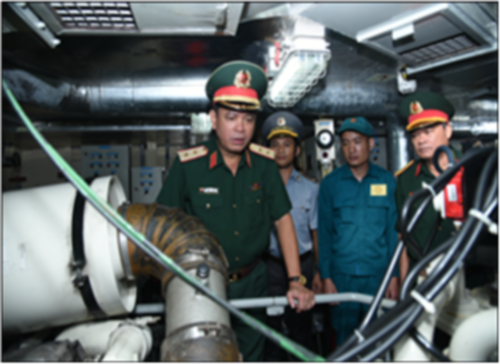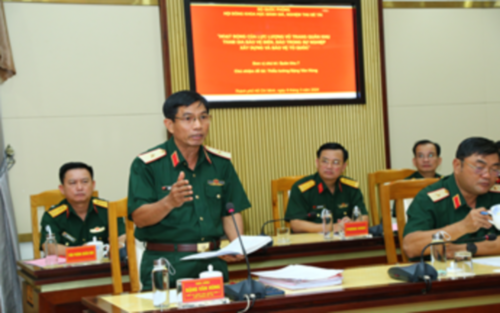Due to the pivotal position of the sea in the defence posture of the whole country and each military region, the 7th Military Region’s Command has paid attention to implementing all contents and solutions for building its potential and defence posture at sea. The main of which is to build the strong military posture at seas and islands, meeting the demand for safeguarding the Fatherland in the new situation.
Vietnam is a coastal country with large seas and the coastline stretching from the North to South. Seas and islands which are sacred parts of the Fatherland have an important strategic position in terms of politics, economy, defence, security and foreign affairs. In the history of building and defending the country, the enemies, when invading our country, often made attacks from sea. In the war to protect the Fatherland (if happens), sea is still the main direction used by the enemies to carry out their invasion. Hence, building the defence posture in the whole country in general, the strong military posture at seas and islands in the 7th Military Region (MR7) in particular is one of the important and urgent tasks.
 |
| Leader of MR7 checks the vehicle of the militia fleet of Ba Ria - Vung Tau Military Command |
Grasping and implementing the 8th Central Resolution (13th tenure) on Strategy to protect the Fatherland in the new situation; resolutions and legal documents related to the task of defending the military region and building the defence zones, especially Resolution No. 28-NQ/TW, dated 22 September 2008 by the Politburo (10th tenure), Decree No. 152/2007/NĐ-CP, dated 10 October 2007, Decree No. 21/2019/NĐ-CP, dated 22 February 2019 by the Government, the MR7’s Party Standing Committee and Command have advocated implementing all the defence and military works, in which attention is paid to the building of all-people national defence with the core being the strong and in-depth military posture at seas and islands to make the foundation for improving the overall quality and the combat power of the MR7’s armed forces, meeting the task requirement of coordinating with other forces to protect the Fatherland from sea in all situations.
However, when making the invasion attacks from sea, the enemies will use the combined forces (including navy, marines, aviation, electronic warfare, etc.) with modern vehicles, high-tech weapons and powerful fire; the operational situations happens fiercely both in the air, at sea, islands and in electronic environments with large spacious scale. This requires the Military Region to strengthen the reinforcement and building of the potential and defence posture, focusing on building the military posture at sea right in the peacetime with many synchronous and suitable solutions, focusing on intensely building the posture of forces taking part in protecting the seas, islands and battlefield facilities according to the defined plans and determination.
The main forces of the Military Region are the key ones participating in the protection of seas and islands. Hence, these forces’ posture has played an important and direct role deciding the capacity of combat task completion in all situations. In order to build a stable posture, based on the research and forecast of combat objects, all-round situations, plans and determination, etc., the Military Region has paid attention to building a stable posture for these forces so that they could make convenient defence and attacks, suitable commands and combat combination, flexible transformation to destroy the enemies with many combat plans; required the infantry divisions and regiments, and the military arms’ brigades to closely combine the attack posture and defence one, give more focus on the main directions and seas which are important and suitable for timely deploying forces to prevent and defeat the enemies attacking from all directions and in all weather conditions, steadily holding all essential regions and targets in important seas and islands (including Phu Quy, Con Dao).
For the posture of the defence forces, based on the determination of defence, the Military Region has directed the suitable deployment of forces in all islands, clusters of islands, coastal defence zones and the main defence directions so that they could complete the tasks in all situations and readily support other forces; at the same time, proactively anticipated the directions (or regions) that the enemies could concentrate their forces and vehicles, then, selected the favourable terrains to build the posture for these forces. The Military Region has required some coastal provinces and cities (including Ho Chi Minh City, Ba Ria – Vung Tau, Binh Thuan) to make effort to build the pivotal defence zones, operational positions, in-depth key posture in order to prevent, repel and defeat any enemies’ attacks to the islands, clusters of islands and the coastal defence zones.
Due to the features of the wide coastal areas in the Military Region with many narrow river passages and landing zones which are suitable for the enemies to deploy their forces and carry out their attacks, creating changes in the battlefields, the Military Region has required that postures be built uninterrupted and solid but adjustable to bring about advantages and initiatives for proactively defeating all combat tactics of the enemies. When participating in the people’s war posture safeguarding the Fatherland developed in a higher level, the local armed forces make a wider operation while the main forces of the Military Region concentrate in the key and pivotal areas to carry out the wars of attrition and large destruction. Therefore, the Military Region has established the defence fulcrums and groups of fulcrums, and when necessary, it would established defence positions at regiment level. Immediately, the Region has paid attention to making research and anticipation, and gradually built the key and spare battlefields, in more suitable conditions, built the systems of firm fortifications, tunnels, headquarters, firing battlefields, etc. to make the stable defence posture for the Region in islands, clusters of islands, and the defence zones in coastal provinces and cities to be ready to respond to any possible situations. Together, the Military Region has directed the adjustment of stationing areas for mobile forces units to be suitable with plans on building the all-people national defence posture in the strategic regions and areas right in peacetime. Offices and units should base on the combatting plans and determination to protect the seas and islands, and the anticipation of areas where the enemies could make raids, air landings, diversions, etc. to build their postures and deploy their forces in these regions and areas to protect the seas and islands.
 |
| Leader of MR7 reports on a MOD-level research project |
Building the posture of the local armed forces (local forces, militia and self-defence forces) is the matter of building and placing parts of posture of the defence zones in coastal provinces and cities. Based on the combat plans, determination and the assigned tasks of protecting the seas and islands, the Military Region has proactively implemented the building of gradually stable military posture of the defence zones in coastal provinces and cities to timely solve any situations of defence and security in peacetime, at the same time, discover, prevent, restrict, surround, divide, and destroy the enemies’ forces and vehicles in the seas and islands. In the building process, the Military Region has required to intensely combine the posture of the local forces with the one of militia and self-defence forces; taken full advantage and effectively brought into play the systems of fortifications, battlefields, obstacles, manoeuvre routes, facilities which have been prepared and built in all directions and areas, especially in the major seas and islands undertaken by the Military Region. The combination of postures is to assure the coordination between the postures of regular forces, local forces and the ones of militia and self-defence forces, departments, fields, unions, etc., making sure the connection and support for one another in each task, situation, area and specific target in struggling against the trespassing foreign forces and attacking the enemies invading the seas, islands and mainland. It is necessary to prepare for building the posture of forces according to the combat plans in each area in order to make timely changes, quickly, flexibly and suddenly solve any situations, and effectively attack the enemies, at the same time, make sure that the Military Region’s armed forces have been provided with enough materials, logistic and technical vehicles, been able to move and change fast, secretly and suddenly, and timely supported one another in their attacks.
Building the battlefield facilities is an important content in building the military posture in general, the Military Region’s ones in seas and islands in particular, together with the posture of other forces, to create a complete, uninterrupted and stable posture. To make it happen, the Military Region has directed the localities and units to take full advantage of the terrains in islands, clusters of islands and the defence zones in coastal areas in order to build the systems of battlefield facilities which are wide, in-depth and focused in the key directions and areas. The units and localities need to base on the determination of defence in each area to identify the main areas to intensely build the strong defensive works, fortifications, tunnels, secret trenches combined with the spare and ready-made battlefields in order to stand firm and attack the enemies in long time. Regarding the obstacles, the Military Region has required all forces to attentively build the systems of obstacles on land, water and sea including both explosive and inexplosive obstacles to prevent and decrease the enemies’ speed of movement and actions at sea, and their attacks to islands and coastal defence zones. The systems of obstacles need being placed according to the combat plans of the Military Region, the defence zones in coastal provinces and cities, and the naval and engineering forces, at the same time, combined closely with the systems of firepower and fortifications. The obstacles need to be concentrated in the main directions and areas of the Military Region, the ones where the enemies could mainly move and attack at sea, and ones that could threaten the main targets. The firepower systems should be closely placed in many layers, connected with other forces’ to fully and effectively exploit each type in both independent or individual fighting and intensive or combined operation; meanwhile, it is necessary to have solutions for preventing the scouts, electronic warfare, cyber warfare and high-tech weapons from the enemies. In building the system of manoeuvre routes, it is necessary to establish a network of widespread routes in order to timely move forces and vehicles within the Military Region, in each defensive area, defence zone and battle of the Region. In the system of routes crossing the important roads, there are some main areas which need to be protected with strong firepower, and connected with some bypasses so that the Region’s armed forces could move safely.
Based on the operation posture to protect the seas and islands which has been partly built in peacetime, in wartime to come, it is necessary to make some adjustment and addition in order to make timely, flexible and suitable changes to the specific happenings in each stage and task of protecting the seas and islands, especially the change of posture regarding the tasks of main operations and key battles at sea, in islands, clusters of islands and coastal defence zones to bring into play the overall power, improve the combatting capacity of the MR7’s armed forces, gaining the victory in protecting the seas, islands and safeguarding the sacred sovereignty of the Fatherland.
Major General DANG VAN HUNG, Deputy Commander, Chief of Staff of the Military Region